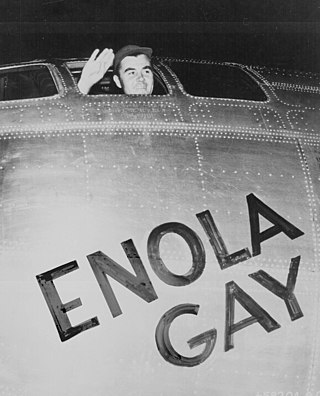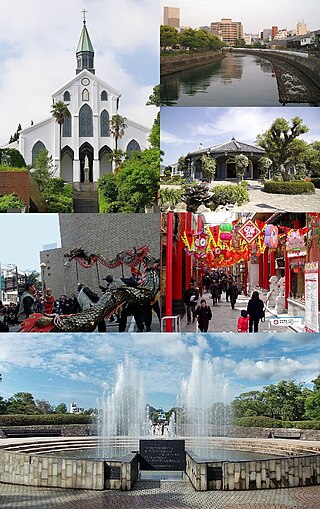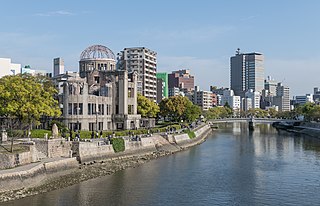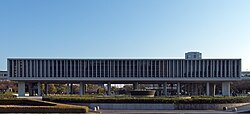
The Enola Gay is a Boeing B-29 Superfortress bomber, named after Enola Gay Tibbets, the mother of the pilot, Colonel Paul Tibbets. On 6 August 1945, during the final stages of World War II, it became the first aircraft to drop an atomic bomb in warfare. The bomb, code-named "Little Boy", was targeted at the city of Hiroshima, Japan, and caused the destruction of about three quarters of the city. Enola Gay participated in the second nuclear attack as the weather reconnaissance aircraft for the primary target of Kokura. Clouds and drifting smoke resulted in Nagasaki, a secondary target, being bombed instead.

Little Boy was the name of the type of atomic bomb used in the bombing of the Japanese city of Hiroshima on 6 August 1945 during World War II, making it the first nuclear weapon used in warfare. The bomb was dropped by the Boeing B-29 Superfortress Enola Gay piloted by Colonel Paul W. Tibbets Jr., commander of the 509th Composite Group, and Captain Robert A. Lewis. It exploded with an energy of approximately 15 kilotons of TNT (63 TJ) and caused widespread death and destruction throughout the city. The Hiroshima bombing was the second nuclear explosion in history, after the Trinity nuclear test.

Nagasaki, officially known as Nagasaki City is the capital and the largest city of the Nagasaki Prefecture on the island of Kyushu in Japan.

Hiroshima is the capital of the Hiroshima Prefecture in Japan. As of June 1, 2019, the city had an estimated population of 1,199,391. The gross domestic product (GDP) in Greater Hiroshima, Hiroshima Urban Employment Area, was US$61.3 billion as of 2010. Kazumi Matsui has been the city's mayor since April 2011. The Hiroshima metropolitan area is the second largest urban area in the Chugoku region of Japan, following the Okayama metropolitan area.

The Hiroshima Peace Memorial, originally the Hiroshima Prefectural Industrial Promotion Hall, and now commonly called the Genbaku Dome, Atomic Bomb Dome or A-Bomb Dome, is part of the Hiroshima Peace Memorial Park in Hiroshima, Japan and was designated a UNESCO World Heritage Site in 1996.

The effects of a nuclear explosion on its immediate vicinity are typically much more destructive and multifaceted than those caused by conventional explosives. In most cases, the energy released from a nuclear weapon detonated within the lower atmosphere can be approximately divided into four basic categories:

"Duck and cover" is a method of personal protection against the effects of a nuclear explosion. Ducking and covering is useful in offering a degree of protection to personnel located outside the radius of the nuclear fireball but still within sufficient range of the nuclear explosion that standing upright and uncovered is likely to cause serious injury or death. In the most literal interpretation, the focus of the maneuver is primarily on protective actions one can take during the first few crucial seconds-to-minutes after the event, while the film of the same name and a full encompassing of the advice also cater to providing protection up to weeks after the event.

Hibakusha is a word of Japanese origin generally designating the people affected by the atomic bombings of Hiroshima and Nagasaki at the end of World War II.

Father Hubert Friedrich Heinrich Schiffer, S.J. was a German Jesuit who survived the atomic bomb "Little Boy" dropped on Hiroshima.

Nagasaki Peace Park is a park located in Nagasaki, Japan, commemorating the atomic bombing of the city on August 9, 1945 during World War II. It is next to the Atomic Bomb Museum and near the Peace Memorial Hall.

Hiroshima Peace Memorial Park is a memorial park in the center of Hiroshima, Japan. It is dedicated to the legacy of Hiroshima as the first city in the world to suffer a nuclear attack at the end of World War II, and to the memories of the bomb's direct and indirect victims. The Hiroshima Peace Memorial Park is visited by more than one million people each year. The park is there in memory of the victims of the nuclear attack on August 6, 1945, in which the United States dropped an atomic bomb on the Japanese city of Hiroshima. The Hiroshima Peace Memorial Park was planned and designed by the Japanese Architect Kenzō Tange at Tange Lab.

Atomic tourism or nuclear tourism is a recent form of tourism in which visitors learn about the Atomic Age by traveling to significant sites in atomic history such as nuclear test reactors, museums with nuclear weapon artifacts, delivery vehicles, sites where atomic weapons were detonated, and nuclear power plants.

The Nagasaki Atomic Bomb Museum is in the city of Nagasaki, Japan. The museum is a remembrance to the atomic bombing of Nagasaki by the United States of America 9 August 1945 at 11:02:35 am. Next to the museum is the Nagasaki National Peace Memorial Hall for the Atomic Bomb Victims, built in 2003. The bombing marked a new era in war, making Nagasaki a symbolic location for a memorial. The counterpart in Hiroshima is the Hiroshima Peace Memorial Museum. These locations symbolize the nuclear age, remind visitors of the vast destruction and indiscriminate death caused by nuclear weapons, and signify a commitment to peace.

The Fukuromachi Elementary School Peace Museum is a peace museum in Fukuromachi, Naka-ku, Hiroshima, Japan. The school was one of the closest schools to ground zero when the atomic bomb fell on August 6, 1945. They lost about 160 students and teachers and the building was heavily damaged. After a few days, the school became a first aid station, and its black burned wall became a message board to find missing people. The Peace Museum is the section of the school building with the basement of the former Municipal Fukuromachi Elementary School in Hiroshima. The school is keeping it as a relic of the atomic explosion, to foster peace, and to send their information to the world.

On 6 and 9 August 1945, the United States detonated two atomic bombs over the Japanese cities of Hiroshima and Nagasaki respectively. The bombings killed between 129,000 and 226,000 people, most of whom were civilians, and remain the only use of nuclear weapons in an armed conflict. Japan surrendered to the Allies on 15 August, six days after the bombing of Nagasaki and the Soviet Union's declaration of war against Japan and invasion of Japanese-occupied Manchuria. The Japanese government signed the instrument of surrender on 2 September, effectively ending the war.

Sumiteru Taniguchi was a survivor of the 1945 atomic bombing of Nagasaki, a prominent activist for a treaty prohibiting nuclear weapons, and chairman of the Nagasaki Council of A-Bomb Sufferers.

Ninoshima is an island in the Seto Inland Sea, located near Hiroshima. Gakuen-mae pier on Ninoshima is located 4 km from Hiroshima (Ujina) Port. It takes only half an hour to get to Ninoshima from wharf 4 of Hiroshima Port by ferry. The island is 3.87 km2 in size, and topped with the mountain Aki-no-Kofuji (278 m). In Japanese, the mountain's name means "Little Fuji of Aki". The name of the island means "resemblance island", as the shape of the island and its mountain resemble Mount Fuji.

The Nagasaki National Peace Memorial Hall for the Atomic Bomb Victims is a commemorative monument in Nagasaki, Japan, situated next to its Atomic Bomb Museum. The Peace Park is nearby.

Tsutomu Yamaguchi was a Japanese marine engineer and a survivor of both the Hiroshima and Nagasaki atomic bombings during World War II. Although at least 70 people are known to have been affected by both bombings, he is the only person to have been officially recognized by the government of Japan as surviving both explosions.





























